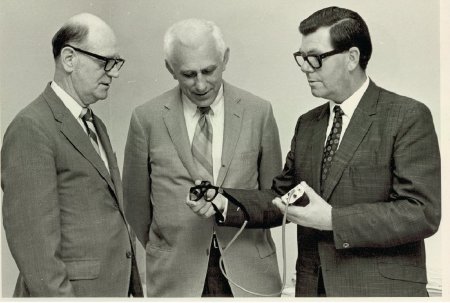Object ID:
2007.33.1.250
Title:
John Eichorn, Donald Blasch, and Leslie Kay examine a Sonic Guide ETA
Date:
ca. 1970
Description:
BW print; (L to R) John Eichorn, Donald Blasch, and Leslie Kay; Kay holds a Sonic Guide out for examination.
John Eichorn set up the university training program at Boston College in 1960, Blasch did the same at Western Michigan in 1961.
During the 1950s, Dr. Leslie Kay worked for the British Navy developing underwater sonar technology to find submerged objects like submarines and mines. Conceived by Kay in 1959 at the University of Birmingham, the Sonicguide was not fully functional until 1966. The first evaluations took place in Australia and New Zealand. By 1971, it was being widely tested in the U.S. Unlike the Russell Pathsounder, with its emphasis on go-no go information, the Sonicguide communicated an abundance of information, providing distance estimation, directional information, and tonal information that promised to provide object identification with considerable practice. Intended as a secondary ETA used with a dog or long cane, it was the subject of several courses for trainers throughout the 1970s and early 1980s. By 1975, under the supervision of Russell Smith, the Sonicguide was being developed by Wormald International, whose Sensory Aids Division became an ancestor of accessibility product vender Humanware.
John Eichorn set up the university training program at Boston College in 1960, Blasch did the same at Western Michigan in 1961.
During the 1950s, Dr. Leslie Kay worked for the British Navy developing underwater sonar technology to find submerged objects like submarines and mines. Conceived by Kay in 1959 at the University of Birmingham, the Sonicguide was not fully functional until 1966. The first evaluations took place in Australia and New Zealand. By 1971, it was being widely tested in the U.S. Unlike the Russell Pathsounder, with its emphasis on go-no go information, the Sonicguide communicated an abundance of information, providing distance estimation, directional information, and tonal information that promised to provide object identification with considerable practice. Intended as a secondary ETA used with a dog or long cane, it was the subject of several courses for trainers throughout the 1970s and early 1980s. By 1975, under the supervision of Russell Smith, the Sonicguide was being developed by Wormald International, whose Sensory Aids Division became an ancestor of accessibility product vender Humanware.
Print Size:
8 x 10"
